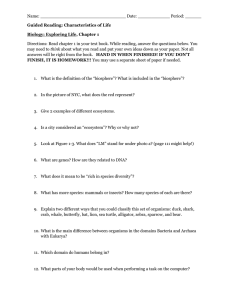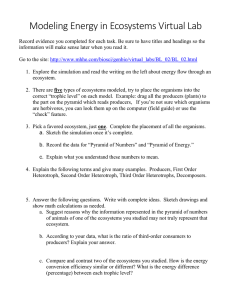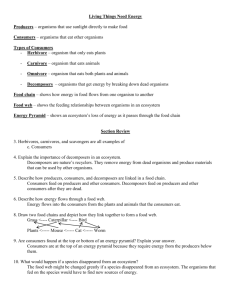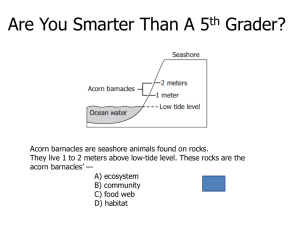energy
advertisement
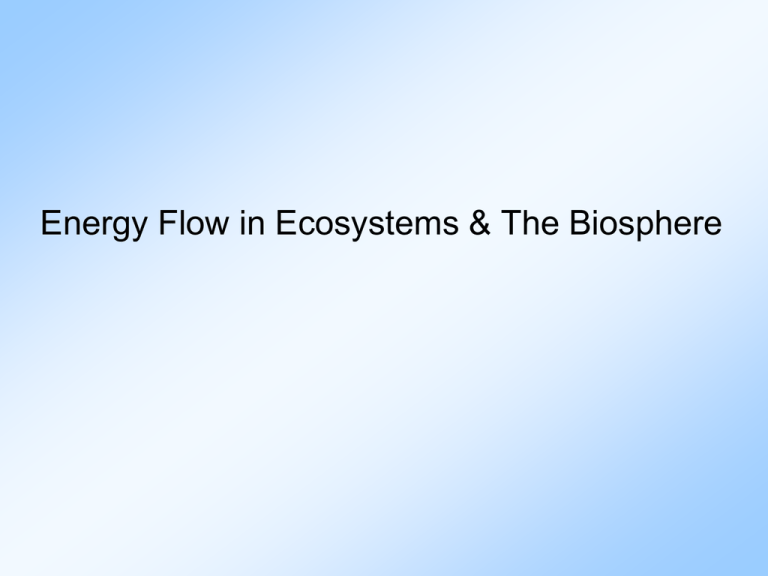
Energy Flow in Ecosystems & The Biosphere Slide # 2 Important Vocabulary 1. Ecology: study of the relationships among organisms & between organisms & their physical environments. 2. Population: all members of a species living in a given location 3. Habitat: place where an organism lives 4. Community: all the interacting populations in a given area 1. Give an example of a population. 2. Give an example of a community. Slide # 3 Important Vocabulary 5. Ecosystem: all members of a community & the physical environment in which they live a. Biotic factors: all living things b. Abiotic factors: all non-living things such as: – Temperature, precipitation, sunlight, soil, salt content, pH 6. Biome: large, stable groups of ecosystems that share the same biotic and abiotic factors 7. Biosphere: portion of earth in which all living things exist Earth’s biosphere includes all biomes, the atmosphere, the lithosphere, & hydrosphere (oceans & lakes). Slide # 4 Ecological Levels of Organization Smallest Largest Individual Population Community Ecosystem Biome Biosphere Go to Section: Slide # 5 Flow of Energy in an Ecosystem Decomposers Sunlight Producers Consumers 1. Trophic level: each level of energy flow 2. Producers (autotrophs):make own food from energy source a. Photosynthesis: plants & algae; transform light energy into chemical energy b. Chemosynthesis: some bacteria use chemical energy in inorganic molecules or heat as energy source Slide # 6 Consumers: Depend on Other Organisms for Food 3. Consumers: organisms that cannot make own food a. Get energy by eating producers & other consumers b. Primary consumers: eat producers • Herbivores: plant eaters c. Secondary consumers: eat other consumers • Omnivores: eat plants & animals • Carnivores: eat only animals 4. Decomposers: obtain energy by breaking down the remains of dead organisms Identify the different types of consumers! Principle Decomposers: Decomposers Obtain energy from the remains of other organisms *Bacteria *Fungi Must know! Earthworms and termites aid in the breakdown of organic matter, which replenishes nutrients to the soil. Slide # 7 A Marsh Food Web 5. Identify examples of the different trophic levels in the marsh ecosystem at the right. a. Producers: b. Primary consumers: c. Secondary consumers: d. Decomposers Go to Section: Slide # 8 Food Chains Show the Transfer of Energy 10,000 kcal 1,000 kcal 100 kcal 10 kcal 1. Food Chains: show the transfer of energy through a series organisms – ENERGY FLOWS IN ONE DIRECTION! 2. 10% rule: typically only 10% of the energy at one level is transferred to the next level a. Energy is used by organisms for cell processes, respiration, capturing prey, and reproduction b. Explains why most food chains don’t have more than 4 or 5 trophic levels Slide # 9 Food Webs Show Interconnected Food Chains 1.All food chains in a community interconnect to form one food web. 2.A change in population of one organism can affect all other organisms in the food web. 3.Arrows point in the direction of energy flow. – Energy flows in one direction! Which organisms would be affected if all of the wolves were removed from the food web? Slide # 11 Ecological Pyramids: Show the Amount of Matter or Energy in an Ecosystem 1. Pyramid of numbers: shows how many individuals are required to support the next level of feeding. 2. Usually does not illustrate the actual amount of organism mass (stored energy) that is transferred through each feeding level. 6 birds 1,000,000 insects 1 tree An inverted numbers pyramid Slide # 12 Energy Pyramid: Total Energy Available at Each Level 1. Energy pyramid: shows amount of energy available at each level 2. Shows that about 90% of the energy is lost as heat ~ 10% is transferred to the next level Slide # 13 Biomass Pyramid: Total Living Material at Each Level 1. Biomass: amount of living tissue 2. Gives the amount of living tissue at each trophic level 3. Represents the amount of food available in each trophic level in an ecosystem. Slide # 15 The Water Cycle 1. Water enters atmosphere by: – Transpiration : trees releasing water through leaves – Respiration: animals exhaling water – Evaporation: from surface water 2. Precipitation: water returns to Earth in the form of rain, snow, hail, & sleet 3. Groundwater: water that seeps into the ground 4. Run off: water that runs off the surface Surface & ground water may run into oceans, lakes & rivers and streams Slide # 16 The Carbon Cycle 1. In photosynthesis, producers remove CO2 gas from the atmosphere to make organic molecules (sugars) 2. Animals get organic molecules from plants & return CO2 gas to the atmosphere through respiration. 3. Fossil fuels, (Coal, oil, natural gas) were once living organic material. When they are burned, CO2 gas is returned to the atmosphere and increases the amount of CO2 gas in the air. Slide # 17 The Nitrogen Cycle 1. Nitrogen fixation: actions by some bacteria & lightning change N2 gas into forms (NH4+ and NO3-). 2. Plants absorb these forms through their roots. 3. Herbivores obtain nitrogen from the plants they eat. 4. Decomposers break down animal waste, dead animals, & dead plant material & return the nitrogen to the soil. Other bacteria return nitrogen in the soil back to the atmosphere. Slide # 14 TAKS Practice How much energy would be available to the organisms in level C? A. all of the energy in level A, plus the energy in level B B. all of the energy in level A, minus the energy in level B C. a percentage of the energy contained in level B D. a percentage of the energy synthesized in level B and level D An energy pyramid is represented below. Which way does energy flow in an ecosystem? From sun to producers (base) to consumers (above). Which level has the most energy? A Which level has the least energy? D Correct answer: C TAKS Practice The mouse population would most likely decrease if there were A an increase in the grass populations B a decrease in the snake and hawk populations C an increase in the number of decomposers in the area D a decrease in the amount of available sunlight Correct answer: D; mice eat grass which depends on sunlight for photosynthesis What does this diagram show? Food Web

